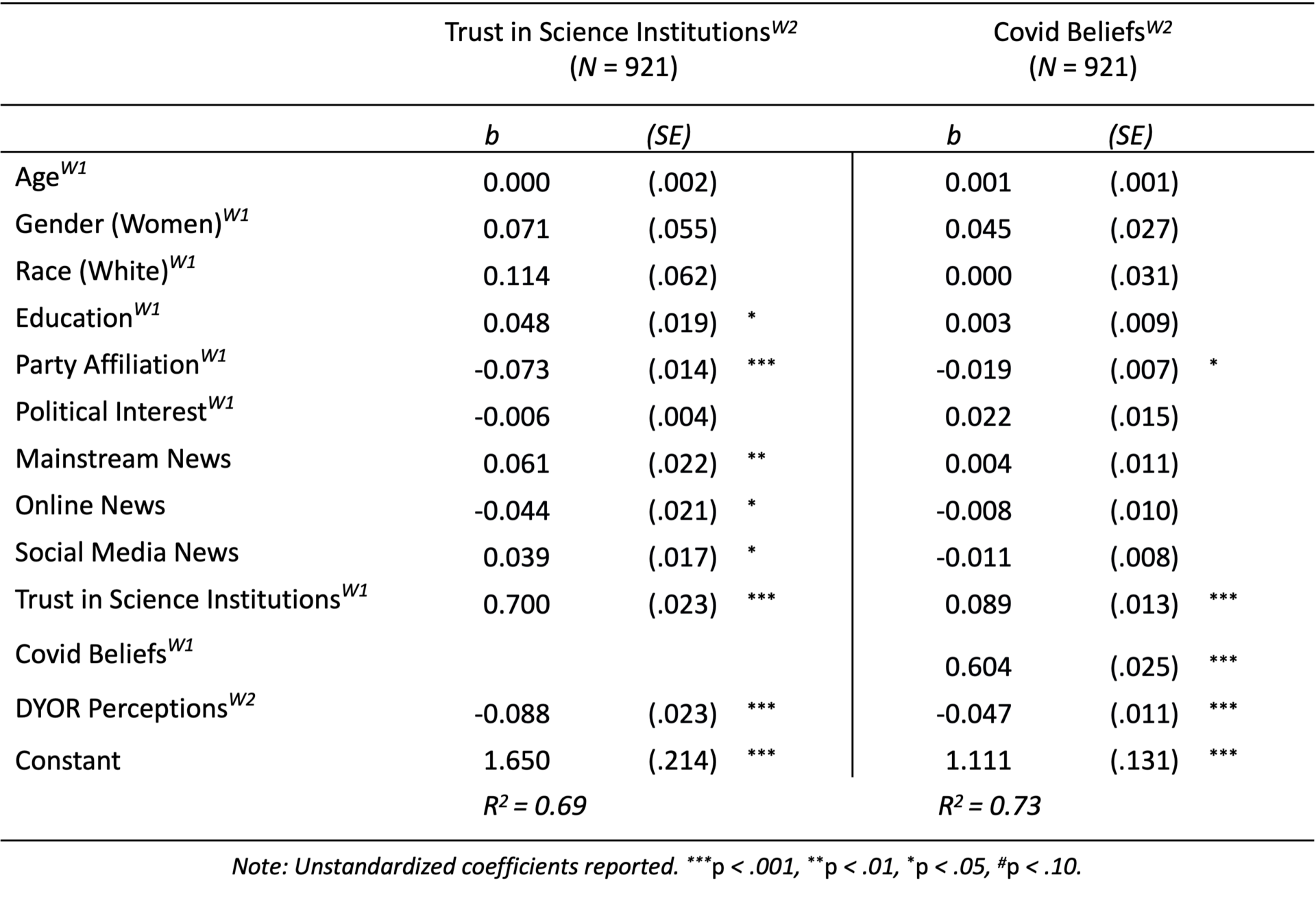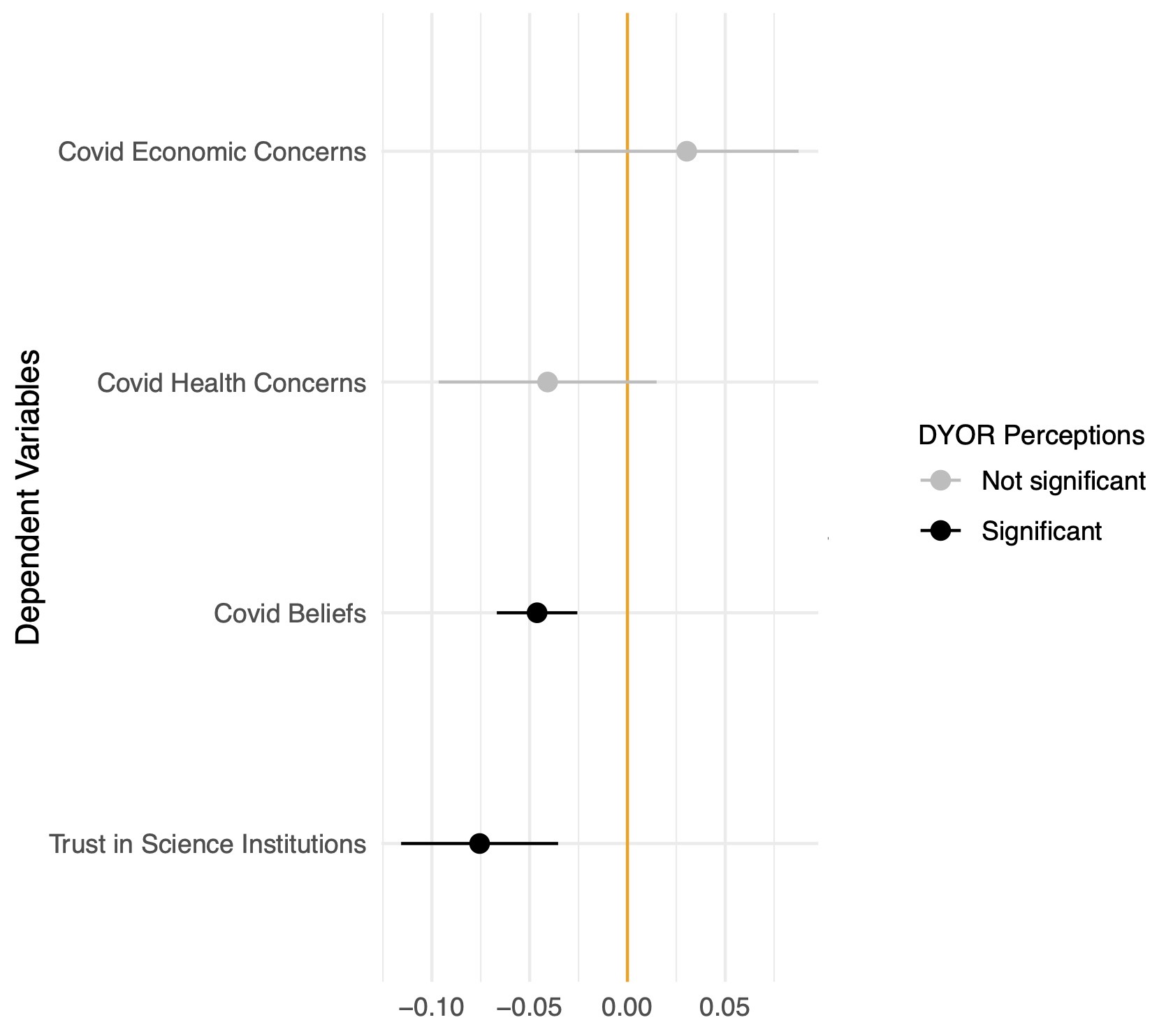Peer Reviewed
Support for “doing your own research” is associated with COVID-19 misperceptions and scientific mistrust
Article Metrics
11
CrossRef Citations
PDF Downloads
Page Views
Amid concerns about misinformation online and bias in news, there are increasing calls on social media to “do your own research.” In an abundant information environment, critical media consumption and information validation are desirable. However, using panel survey data, we find that positive perceptions toward “doing your own research” are associated with holding more misperceptions about COVID-19 and less trust in science over time. Support for “doing your own research” may be an expression of anti-expert attitudes rather than reflecting beliefs about the importance of cautious information consumption.

Research Questions
- How are perceptions of “doing your own research” associated with trust in science institutions?
- How are perceptions of “doing your own research” associated with holding accurate beliefs about COVID-19?
- How are perceptions of “doing your own research” associated with concerns about COVID-19?
Research note Summary
- This study drew upon a two-wave panel survey of U.S. adults administered by YouGov in December 2020 and March 2021 to examine how perceptions of “doing your own research” were associated with beliefs about COVID-19, concerns about the health and economic impacts of COVID-19, and trust in science institutions.
- Positive perceptions of “doing your own research” were associated with less trust in science institutions and believing more misinformation about COVID-19 over time but had no impact on concerns about COVID-19.
- Calls to “do your own research” often use language that appeals to democratic ideals, personal freedoms, and individual empowerment. But strong support for doing one’s own research may instead reflect anti-expert attitudes and mistrust, leading to inaccurate beliefs.
Implications
Concerns about misinformation are prevalent among the U.S. public and elsewhere in the world (Berthel et al., 2016). People are aware of the need to be skeptical consumers of information and that some information they encounter may be misleading or false (Guess et al., 2020). Yet there is also a rising sense of distrust in experts, including scientists and journalists, as trustworthy sources of information (Rainie et al., 2019) and vocal skepticism of information about public health, novel technologies, and scientific research (Merkley, 2020; Rutjens et al., 2022). Though trust in science remains high (Funk et al., 2020), a growing number of people assert it is better to “do your own research” (DYOR) than rely on information provided by scientists, doctors, or other credentialed experts (Carrion, 2018).
The phrase “do your own research” (DYOR) was made a slogan by American conspiracy theorist Milton William “Bill” Cooper in the 1990s (Ballantyne et al., 2022) and has been frequently used by anti-vaccine advocates online since the 2010s (Kata, 2012). These calls encourage individuals to seek additional or alternative sources of information, verify facts, and examine evidence to make informed decisions that best suit one’s individual circumstances. However, DYOR calls became more visible to the broader public during the COVID-19 pandemic, where they were common in online content about QAnon, a conspiratorial group describing themselves as a “community of researchers” dedicated to uncovering hidden truths behind current events (Marwick & Partin, 2022; Pasquetto et al., 2022).
We leveraged panel survey data to investigate how perceptions of “doing your own research” were associated with trust in science, beliefs, and concerns about COVID-19. Our results revealed that positive DYOR perceptions were associated with more COVID-19 misperceptions and less trust in scientific institutions, even when controlling for previous beliefs and levels of trust. This may be because DYOR reflects epistemic beliefs that one’s gut feelings and “alternative facts” from independent research are as or more legitimate means of forming beliefs as scientific evidence and that truth is relative to each person’s unique experience (Carrion, 2018; Kata, 2012; Marwick & Partin, 2022; Pasquetto et al., 2022). As people more strongly adopt DYOR epistemic beliefs, they may have greater justification for engaging in motivated reasoning and cherry-picking expert voices to support appealing beliefs, even when those beliefs oppose a consensus of institutional experts.
The panel analyses found DYOR perceptions only explain about 1% of the variance in both trust in science and COVID-19 misperceptions when controlling for prior levels of the dependent variables (and about 5% of the variance in cross-sectional analyses). This suggests that potential effects of DYOR perceptions are small but may accumulate over time. Though survey waves were only three months apart, DYOR perceptions were nevertheless associated with decreased trust in science and increased misperceptions in that short time. Over more months or years, positive DYOR perceptions may have substantial influence on trust in institutions and false beliefs across a range of issues.
These findings have several implications for understanding how people make sense of contemporary information environments. First, though we do not identify what kinds of research or information seeking people may do, it suggests that favorable DYOR perceptions may be associated with biased information processing or seeking untrustworthy information. People often overestimate their abilities to seek and interpret information (e.g., Atir et al., 2015), and tend to search for information that aligns with preexisting values, beliefs, and identities (Lord et al., 1979). Perceptual biases can lead to inaccurate conclusions, particularly when individuals lack topic knowledge, training in scientific methods (Ballantyne & Dunning, 2022), or rely on gut feelings (Garrett & Weeks, 2017).
Second, calls to DYOR may promote skepticism of science institutions and mainstream information sources by highlighting how they might mislead the public. These calls may reflect perceptions that science institutions or mainstream news media are corrupt or have a hidden agenda hostile to one’s worldviews and goals (Kata, 2012; Perloff, 2015). While DYOR messages are not exclusively used to promote misinformation (e.g., some emphasize the safety of COVID-19 vaccines; Kelsey, 2021), our results show that DYOR perceptions are associated with distrust of science institutions and COVID-19 misperceptions. It is possible that even well-intentioned calls to DYOR could foster skepticism of official information sources.
Finally, doing your own research may not be about seeking information but instead be expression of anti-establishment political identity. In cases of anti-vaccine sentiment, DYOR is often invoked in conjunction with resentment towards doctors and scientists who dismiss personal experience and intuition (e.g., Carrion, 2018). DYOR may be a manifestation of contempt for elites rather than an affirmation of the importance of independent research.
“Doing your own research” is both a prudent and flawed endeavor. Informed and engaged individuals are widely considered normatively good in health, science, and politics (e.g., Korda & Itani, 2013). Marginalized groups who have legitimate reasons to be wary of institutions often benefit from outside research and expertise (e.g., Bond et al., 2021). Further, blind trust in experts can lead to politicization of science and policies that do not align with public interest, making healthy skepticism and independent research democratically desirable (Krause et al., 2021). Rather than discouraging DYOR, which could elicit reactance for infringing on freedom of thought (Brehm, 1966), it may be fruitful to advance media literacy interventions that address information seeking biases and provide logic-based corrective interventions about rhetorical strategies, including DYOR messages, that might promote misinformation (Vraga et al., 2020).
Scientific research and institutions are not without problems, from news biases to structural discrimination in healthcare (Bond et al., 2021). However, the idea that expert institutions and mainstream news have nefarious motivations can foster distrust and influence information-seeking in ways that undermine democratic norms and values (Hutchens et al., 2021). Our research provides initial support for concerns some have expressed about DYOR messages (Ballantyne & Dunning, 2022). However, while controlling for prior levels of the outcomes provides some evidence that DYOR perceptions lead to changes trust and beliefs, these data do not account for exposure to DYOR messages or whether such messages cultivate positive DYOR perceptions. Future research should explore whether support for DYOR is a response to fears about disinformation or reflective of anti-establishment superordinate worldviews, and the potential effects of DYOR messages on information seeking and attitudes about science, politics, and media.
Findings
Finding 1: Positive perceptions of “doing your own research” were associated with less trust in science institutions.
DYOR perceptions were significantly associated with decreased trust in science institutions, b = -0.09(.02), p < .001, accounting for prior levels of trust in science.
Finding 2: Positive perceptions of “doing your own research” were associated with holding more COVID-19 misperceptions.
DYOR perceptions were significantly associated with decreased belief accuracy about COVID-19, b = -0.05(.01), p < .001, accounting for prior levels of COVID-19 belief accuracy.
Finding 3: Positive perceptions of “doing your own research” were not associated with concern about COVID-19.
DYOR perceptions had no association with either health concerns about COVID-19, b = -0.05(.03), p = .13, or economic concerns about COVID-19, b = 0.02(.03), p = .50, when accounting for prior levels of concern.



Methods
The data for this study are from a two-wave panel survey of U.S. adults administered by YouGov in December 2020 (NW1 = 1,500) and March 2021 (NW2 = 1015). Respondents were matched to a sampling frame on gender, age, race, and education constructed by stratified sampling from the full 2018 American Community Survey. Of Wave 1 respondents, 67.66% returned to complete Wave 2. After removing participants who failed attention checks in either Wave 1 or Wave 2, the final sample was NW1 = 1421 and NW2 = 975. From this sample, 54% of Wave 1 were women, and the average age was 49 years old (SD = 17.96). Sixty-five and a half percent of respondents identified as White, 11.9% as Black, 14.8% as Hispanic, 2.7% as Asian, and the remaining 5% identified as mixed race or other. In the sample, 30.7% had at least a 4-year college degree, and the median income was between $50,000-$59,000. Political affiliation was measured on a 7-point scale from “Strong Democrat” to “Strong Republican” (M = 3.57, SD = 2.14). For more information and full question wording, see Appendix A.
Perceptions of “doing your own research” were measured with three items in both waves. These measures intended to capture agreement that personal research is as valuable as expert knowledge. The items were, “Anyone can be an expert on something if they do enough research,” “I prefer to do my own research rather than rely on experts and intellectuals,” and “The opinions of people who have done their own research are just as valid as the opinions of experts and intellectuals.” Agreement was measured on a scale from 1 (“Strongly disagree”) to 7 (“Strongly agree”) with “neither disagree nor agree” as the scale midpoint. Responses were averaged into a scale of DYOR perceptions (MW1 = 4.16, SDW1 = 1.42, αW1 = .80; MW2 = 3.99, SDW2 = 1.45, αW2 = .82).
Trust in science was measured in both waves with four items asking how trustworthy scientists, colleges and universities, doctors and medical scientists, and the Center for Disease Control were. Response options ranged from 1 (“Extremely untrustworthy”) to 7 (“Extremely trustworthy”). These items averaged into a scale of trust in science institutions (MW1 = 4.79, SDW1 = 1.39, αW1 = .86; MW2 = 4.74, SDW2 = 1.42, αW2 = .87).
We asked participants their beliefs about nine COVID-19 statements in both waves (e.g., “It is possible to transmit COVID-19 to others even if you do not have symptoms”). Respondents indicated their beliefs on a scale from 1 (“Definitely false”) to 5 (“Definitely true”) with “unsure” as the scale midpoint. Items were coded so high values reflected accurate beliefs, then averaged into a scale (MW1 = 3.63, SDW1 = 0.76; α W1 = .81; MW2 = 3.63, SDW2 = 0.84; α W1 = .78).
We had two measures of concern about COVID-19, measured in both waves. Health concerns were measured using two items asking how COVID-19 may affect the health of oneself and others. Economic concerns were asked with two items measuring concern economic impacts to oneself and community. Response options ranged from 1 (“Strongly disagree”) to 7 (“Strongly agree”). These items were averaged into a scale of health concern about COVID(MW1 = 5.05, SDW1 = 1.77, rW1 = .75; MW2 = 4.79, SDW2 = 1.82, r W2 = .75) and economic concern about COVID(MW1 = 5.33, SDW1 = 1.38, r W1 = .43; MW2 = 5.12, SDW2 = 1.41, r W2 = .40).
To examine how DYOR perceptions were associated with trust, COVID-19 beliefs, and concern about COVID-19, we ran four OLS regression models with Wave 2 DYOR perceptions as the main independent variable and Wave 2 measures for each dependent variable. All models controlled for age, gender, race, education, political party affiliation, political interest, and news media use, including traditional news, online news, and social media news. We additionally controlled for Wave 1 trust in science, and Wave 1 measures of the respective dependent variable in each model. All analyses are unweighted.
Topics
- COVID-19
- / Public Health
- / Research
- / Sources
Bibliography
Ballantyne, N., & Dunning, D. (2022, January 3). Skeptics say, ‘Do your own research.’ It’s not that simple. The New York Times. https://www.nytimes.com/2022/01/03/opinion/dyor-do-your-own-research.html
Ballantyne, N., Celniker, J. B., & Dunning, D. (2022). Do your own research. Social Epistemology. https://doi.org/10.1080/02691728.2022.2146469
Berthel, M., Mitchell, A., & Holcomb, J. (2016). Many Americans believe fake news is sowing confusion. Pew Research Center. https://www.pewresearch.org/journalism/2016/12/15/many-americans-believe-fake-news-is-sowing-confusion/
Bond, R. M., Gaither, K., Nasser, S. A., Albert, M. A., Ferdinand, K. C., Njoroge, J. N., Parapid, B., Hayes, S. N., Pegus, C., Sogade, B., & Grodzinsky, A. (2021). Working agenda for Black mothers: A position paper from the Association of Black Cardiologists on solutions to improving Black maternal health. Circulation: Cardiovascular Quality and Outcomes, 14(2). https://doi.org/10.1161/CIRCOUTCOMES.120.007643
Brehm, J. W. (1966). A theory of psychological reactance. Academic Press.
Carrion, M. L. (2018). “You need to do your research”: Vaccines, contestable science, and maternal epistemology. Public Understanding of Science, 27(3), 310–324. https://doi.org/10.1177/0963662517728024
Funk, C., Tyson, A., Kennedy, B., & Johnson, C. (2020). Science and scientists held in high esteem across global publics. Pew Research Center. https://www.pewresearch.org/science/2020/09/29/science-and-scientists-held-in-high-esteem-across-global-publics/
Garrett, R. K., & Weeks, B. E. (2017). Epistemic beliefs’ role in promoting misperceptions and conspiracist ideation. PLOS ONE, 12(9), e0184733. https://doi.org/10.1371/journal.pone.0184733
Guess, A. M., Nyhan, B., & Reifler, J. (2020). Exposure to untrustworthy websites in the 2016 U.S. election. Nature Human Behaviour, 4(5), 472–480. https://doi.org/10.1038/s41562-020-0833-x
Hutchens, M. J., Hmielowski, J. D., Beam, M. A., & Romanova, E. (2021). Trust over use: Examining the roles of media use and media trust on misperceptions in the 2016 US presidential election. Mass Communication and Society, 24(5), 701–724. https://doi.org/10.1080/15205436.2021.1904262
Kata, A. (2012). Anti-vaccine activists, Web 2.0, and the postmodern paradigm – An overview of tactics and tropes used online by the anti-vaccination movement. Vaccine, 30(25), 3778–3789. https://doi.org/10.1016/j.vaccine.2011.11.112
Kelsey [@somuchlifeblog]. (2021, March 4). **SYMPTOM UPDATE: Nothing major with the first dose! My arm was pretty sore on day 2 […] [Photograph]. Instagram. https://www.instagram.com/p/CMA1ohJg4VD/
Korda, H., & Itani, Z. (2013). Harnessing social media for health promotion and behavior change. Health Promotion Practice, 14(1), 15–23. https://doi.org/10.1177/1524839911405850
Krause, N. M., Scheufele, D. A., Freiling, I., & Brossard, D. (2021). The trust fallacy: Scientists’ search for public pathologies is unhealthy, unhelpful, and ultimately unscientific. American Scientist, 109(4), 226–232. https://doi.org/10.1511/2021.109.4.226
Lord, C. G., Ross, L., & Lepper, M. R. (1979). Biased assimilation and attitude polarization: The effects of prior theories on subsequently considered evidence. Journal of Personality and Social Psychology, 37(11), 2098–2109. https://doi.org/10.1037/0022-3514.37.11.2098
Marwick, A. E., & Partin, W. C. (2022). Constructing alternative facts: Populist expertise and the QAnon conspiracy. New Media. https://doi.org/10.1177/14614448221090201
Merkley, E. (2020). Anti-intellectualism, populism, and motivated resistance to expert consensus. Public Opinion Quarterly, 84(1), 24–48. https://doi.org/10.1093/poq/nfz053
Pasquetto, I. V., Olivieri, A. F., Tacchetti, L., Riotta, G., & Spada, A. (2022). Disinformation as infrastructure: Making and maintaining the QAnon conspiracy on Italian digital media. Proceedings of the ACM on Human-Computer Interaction, 6(CSCW1), 1–31. https://doi.org/10.1145/3512931
Perloff, R. M. (2015). A three-decade retrospective on the hostile media effect. Mass Communication and Society,18(6), 701–729. https://doi.org/10.1080/15205436.2015.1051234
Rainie, L., Skeeter, S., & Perrin, A. (2019). Trust and distrust in America. Pew Research Center. https://www.pewresearch.org/politics/2019/07/22/trust-and-distrust-in-america/
Rutjens, B. T., Sengupta, N., van der Lee, R., van Koningsbruggen, G. M., Martens, J. P., Rabelo, A., & Sutton, R. M. (2022). Science skepticism across 24 countries. Social Psychological and Personality Science, 13(1), 102–117. https://doi.org/10.1177/19485506211001329
Vraga, E. K., Kim, S. C., Cook, J., & Bode, L. (2020). Testing the effectiveness of correction placement and type on Instagram. The International Journal of Press/Politics, 25(4), 632–652. https://doi.org/10.1177/1940161220919082
Funding
No funding sources to disclose.
Competing Interests
The authors do not have any potential conflicts of interest to declare.
Ethics
The research protocol was approved by the University of Michigan Internal Review Board (IRB HSBS).
Copyright
This is an open access article distributed under the terms of the Creative Commons Attribution License, which permits unrestricted use, distribution, and reproduction in any medium, provided that the original author and source are properly credited.
Data Availability
All materials needed to replicate this study are available via the Harvard Dataverse: https://doi.org/10.7910/DVN/NOT190
